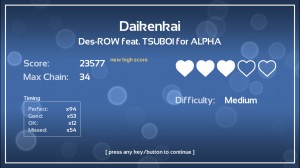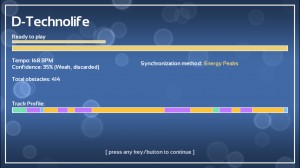The Alpha Gamer #4: Running the Distance with Melody’s Escape

Imagine, if you will, a game that was conceived when Miku Hatsune, Audiosurf, and Dance Dance Revolution got together and made a baby. That’s probably the most accurate way to describe Melody’s Escape, a parkour/running game that uses the player’s music library to dictate the gameplay.
 Much like my favorite music games, Beat Hazard and Audiosurf, Melody’s Escape focuses on creating gameplay through the use of music analysis. However, instead of picking up blocks or shooting down enemies created by the music, Melody’s Escape plays more like DDR than anything else. In true DDR fashion, players have to press a button in time with markers that appear to the beat of the music; each button corresponds to a different direction and can aid Melody in avoiding obstacles. The game’s inputs also become more complex as the difficulty increases in a manner similar to playing DDR on Standard and Heavy modes.
Much like my favorite music games, Beat Hazard and Audiosurf, Melody’s Escape focuses on creating gameplay through the use of music analysis. However, instead of picking up blocks or shooting down enemies created by the music, Melody’s Escape plays more like DDR than anything else. In true DDR fashion, players have to press a button in time with markers that appear to the beat of the music; each button corresponds to a different direction and can aid Melody in avoiding obstacles. The game’s inputs also become more complex as the difficulty increases in a manner similar to playing DDR on Standard and Heavy modes.
 Playing this game with a controller is probably the best way to go, but that doesn’t make the game any easier. Melody’s Escape is pretty brutal to master; the fast pace and complex button inputs can throw off even the most seasoned gamer. Thankfully, the game does not implement a failure system as DDR does; instead, the game scores your performance exactly like yet another popular music-based game: Guitar Hero. As you hit each input, you gain points depending on how perfect you hit it. You earn points for a perfect, good, or ok hit. Meanwhile, your overall performance is scored from 1-5 hearts, much like Guitar Hero’s stars.
Playing this game with a controller is probably the best way to go, but that doesn’t make the game any easier. Melody’s Escape is pretty brutal to master; the fast pace and complex button inputs can throw off even the most seasoned gamer. Thankfully, the game does not implement a failure system as DDR does; instead, the game scores your performance exactly like yet another popular music-based game: Guitar Hero. As you hit each input, you gain points depending on how perfect you hit it. You earn points for a perfect, good, or ok hit. Meanwhile, your overall performance is scored from 1-5 hearts, much like Guitar Hero’s stars.
 There isn’t much more variation to the game, so it’s easy to pick up and play every now and then. I decided to try my hand at the Insane and Overload difficulties after getting used to the Medium difficulty. Insane and Overload are two words that do not exaggerate in the slightest, and I found my eyes spinning after trying to keep up with intense songs. Unlike the simple four-button setup in Medium, Insane takes the next step by introducing directional inputs to avoid obstacles while keeping the buttons for the beat inputs. Overload decides to do just as the name says: overload your senses and confuse everyone but those who’ve practiced. In Overload, obstacles require a direction and button input. It’s similar to the trickier two button corner inputs in a game of DDR.
There isn’t much more variation to the game, so it’s easy to pick up and play every now and then. I decided to try my hand at the Insane and Overload difficulties after getting used to the Medium difficulty. Insane and Overload are two words that do not exaggerate in the slightest, and I found my eyes spinning after trying to keep up with intense songs. Unlike the simple four-button setup in Medium, Insane takes the next step by introducing directional inputs to avoid obstacles while keeping the buttons for the beat inputs. Overload decides to do just as the name says: overload your senses and confuse everyone but those who’ve practiced. In Overload, obstacles require a direction and button input. It’s similar to the trickier two button corner inputs in a game of DDR.
 I do have to say that one of the cooler things that Melody’s Escape does is setting up its frantic pacing. During slower, less intense portions of a song, Melody will slow down to a simple walk and the button inputs will show up closer together. When the song increases in tempo, intensity, and volume, Melody breaks into a run or begins flying through the air at high speeds. This means that each and every song has their own course to run through, and savvy players can memorize each track to increase their scores. This also means that players can choose a slower song if they’ve been getting beat up by their more intense songs.
I do have to say that one of the cooler things that Melody’s Escape does is setting up its frantic pacing. During slower, less intense portions of a song, Melody will slow down to a simple walk and the button inputs will show up closer together. When the song increases in tempo, intensity, and volume, Melody breaks into a run or begins flying through the air at high speeds. This means that each and every song has their own course to run through, and savvy players can memorize each track to increase their scores. This also means that players can choose a slower song if they’ve been getting beat up by their more intense songs.
For example, I chose to play “Leaving Earth” by Clint Mansell from the Mass Effect 3 OST. Besides having a bit of difficulty holding back tears whenever I hear that song (I really love the Mass Effect Trilogy, ok?), its relative softness created an easy five heart run.
In the end, Melody’s Escape is a decent addition to the music-driven family of games, despite the fact that it may feel better played with a DDR pad. Players that like having their games revolve around their music should add this game to their collection and watch it grow. I have confidence that more can and will be added to the game in the future. For now, I can give Melody’s Escape the Alpha Gamer Seal of Approval. Check out the trailer and pick up the game here!

















iStalk? uStalk!